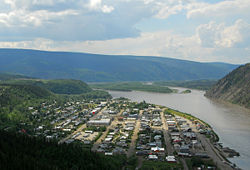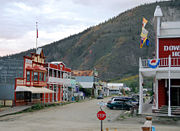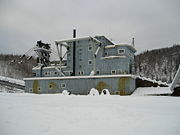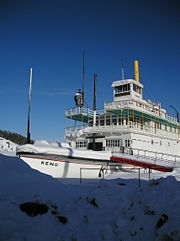Dawson City
| Town of the City of Dawson Dawson City |
|
 |
|
|
|
|
| Coordinates: | |
| Country | |
|---|---|
| Territory | |
| Settled | 1896 |
| City | 1902 |
| Town | 1980 |
| Area | |
| - Total | 32.45 km² (12.5 sq mi) |
| Elevation | 370 m (1,214 ft) |
| Population (2006)[1] | |
| - Total | 1,327 |
| - Density | 41/km² (106.2/sq mi) |
| Time zone | Pacific (PST) (UTC-8) |
| - Summer (DST) | PDT (UTC-7) |
| Canadian Postal code | Y0B 1G0 |
| Area code(s) | 867 |
| NTS Map | 105D11 |
| GNBC Code | KAHFT |
| Website: City of Dawson | |
The Town of the City of Dawson or Dawson City is a town in the Yukon, Canada.
The population was 1,327 at the 2006 census.[1] The area draws some 60,000 visitors each year. The locals generally refer to it simply as 'Dawson', but the tourist industry generally refers to it as 'Dawson City' (partly to differentiate it from Dawson Creek, British Columbia, which is at mile 0 of the Alaska Highway).
Contents |
History
The townsite was named in January 1897 after noted Canadian geologist George M. Dawson, who had explored and mapped the region in 1887. It served as the Yukon's capital from the territory's founding in 1898 until 1952, when the seat was moved to Whitehorse.
Dawson has a much longer history, however, as an important harvest area used for millennia by the Hän-speaking people of the Tr’ondëk Hwëch’in and their forebears. The heart of their homeland was Tr'ochëk, a fishing camp at the confluence of the Klondike River and Yukon River, now a National Historic Site. This site was also an important summer gathering spot and a base for moose-hunting on the Klondike Valley.
The Klondike Gold Rush started in 1896 and changed the First Nations camp into a thriving city of 40,000 by 1898. By 1899, the gold rush had ended and the town's population plummeted as all but 8,000 people left. When Dawson was incorporated as a city in 1902, the population was under 5,000.
The population was fairly stable until the 1930s, dropped after World War II when the territorial capital was moved to Whitehorse and languished around the 600-900 mark through the 1960s and 1970s, but has risen and held stable since then. The high price of gold has made modern mining operations profitable, and the growth of the tourism industry has encouraged development of facilities. In the early 1950s, Dawson was linked by road to Alaska, and in fall 1955, with Whitehorse along a road that now forms part of the Klondike Highway. In 1978, another kind of buried treasure was discovered when a construction excavation inadvertently found a forgotten collection of more than 500 discarded films of fragile nitrate filmstock from the early 20th century that were buried in and preserved in the permafrost. This historical find was moved to Library and Archives Canada and the US Library of Congress for both transfer to safety filmstock and storage.
Geology
Dawson City lies at the western end of the meeting of two continental plates. The line between these plates, called the Tintina Trench, continues eastward for several hundred kilometres. Erosional remnants of lava flows crop out immediately north and west of Dawson City.
Climate
Like most of the Yukon, Dawson City has a subarctic climate. The average temperature in July is 15.6 °C (60 °F) and in January is −26.7 °C (−16 °F). The highest temperature ever recorded is 34.7 °C (94 °F) on May 31, 1983 and the lowest temperature ever recorded is −55.8 °C (−68 °F) on February 11, 1979. It experiences a wide range of temperatures surpassing 30 °C (86 °F) in most summers and dropping below −40 °C (−40 °F) in winter.[2]
The community is at an elevation of 320 m (1,050 ft)[3] and the average rainfall in July is 48.4 mm (1.9 in) and the average snowfall in January is 24.2 cm (9.5 in). Dawson has an average total annual snowfall of 160.0 cm (63.0 in) and averages 90 frost free days per year.[2] The town is built on a layer of ice, which may pose a threat to the town's infrastructure in the future as the permafrost melts.[4][5]
City or town

Dawson was incorporated as a city in 1902 when it met the criteria for "city" status under the municipal act of that time. It retained the incorporation even as the population plummeted. When a new municipal act was adopted in the 1980s, Dawson met the criteria of "town", and was incorporated as such, although with a special provision to allow it to continue to use the word "City", partially for historic reasons, partially to distinguish it from Dawson Creek, a small city in northeastern British Columbia. Dawson Creek is also named in honour of George Mercer Dawson. This led the territorial government to post the following signs at the boundaries of the town: "Welcome to the Town of the City of Dawson".
Law and government
In 2004, the Yukon government removed the mayor and the town council, as a result of the town going bankrupt. The territorial government accepted a large portion of the responsibility for this situation in March 2006, writing off $3.43 million of the debt and leaving the town with $1.5 million still to pay off. Elections were set for June 15, 2006. John Steins, a local artist and one of the leaders of the movement to restore democracy to Dawson, was acclaimed as mayor, while 13 residents ran for the 4 council seats.
The government of Tr’ondëk Hwëch’in First Nation, now a self-governing First Nation, is also located in Dawson.
Industry

Today, Dawson City's main industries are tourism and gold mining.
Gold mining started in 1896 with the Bonanza (Rabbit) Creek discovery by George Carmack, Dawson Charlie and Skookum Jim Mason (Keish). The area's creeks were quickly staked and most of the thousands who arrived in the spring of 1898 for the Klondike Gold Rush found that there was very little opportunity to benefit directly from gold mining. Many instead became entrepreneurs to provide services to miners.
Starting approximately 10 years later, large gold dredges began an industrial mining operation, scooping huge amounts of gold out of the creeks, and completely reworking the landscape, altering the locations of rivers and creeks and leaving tailing piles in their wake. A network of canals and dams were built to the north to produce hydroelectric power for the dredges. The dredges shut down for the winter, but one built for "Klondike Joe Boyle" was designed to operate year-round, and Boyle had it operate all through one winter. That dredge (Dredge No. 4) is open as a national historic site on Bonanza Creek.
The last dredge shut down in 1966, and the hydroelectric facility, at North Fork, was closed when the City of Dawson declined an offer to purchase it. Since then, placer miners have returned to the status of being the primary mining operators in the region.
Besides Tr'ochëk, Dawson is home to several national historic sites many of which are included in the Dawson Historical Complex.[6]
Community profile
According to the Canada 2006 Census:[1][7]
- Population in 2006: 1,327
- Population in 2001: 1,251
- Change 2001 to 2006 population change (%): 6.1
- Total private dwellings: 768
- Population density per square kilometre: 40.9
- Land area (square km): 32.45
Transport and communications


- Airports: Dawson City Airport, located 8 nautical miles (15 km/9.2 mi) east of the town, has a 5,000 ft (1,524 m) gravel runway. Dawson City Water Aerodrome is located next to the community on the Yukon River. Both are classified as an airport of entry and, as such, can handle aircraft with up to 30 passengers. The water aerodrome is one of only two in Canada that that is able to handle aircraft with more than 15 passengers.[8]
- Road: Klondike Highway (Yukon route 2) from Whitehorse; Top of the World Highway (Yukon route 9) and Taylor Highway (Alaska route 5) from Tok, Alaska.
- Rail: none
- Boat: none except for the Highway 9 ferry at the north end of town, although the Yukon River is navigable (when not frozen solid) and historically was travelled by commercial riverboats to Whitehorse and downstream into Alaska and the Bering Sea. Holland America Line also operates a catamaran, The Yukon Queen II, daily (roundtrip) between Dawson City and the town of Eagle, Alaska. This is mainly a service for its package tour customers, though anyone may purchase a ticket for the trip.
- Television: local transmitters for Aboriginal Peoples Television Network and CBC Television English
- Radio: CFYT-FM (local community station, rebroadcasts CKRW Whitehorse when not originating local broadcasts); local transmitters for CBC Radio One (CFWH regional network), CHON-FM
- Newspaper: no daily newspapers locally, Klondike Sun published every two weeks, Yukon News is available three days per week
- Cable television: municipal government-owned system with several channels via satellite
- Telephone/Internet: Northwestel telephone exchange, with ADSL Internet; also dial-up internet from Yknet; cellular service to be introduced during late 2006 or spring 2007
- Electricity: Yukon Energy Corporation (hydro from the Mayo, Yukon dam, diesel back-up)
Famous residents
Dawson City is also home of the Berton House Writers' Retreat program, housing established Canadian writers for four three-month get-away-from-it-all subsidized residencies each year. Berton House was the childhood home of popular-history writer Pierre Berton, and is across the street from the cabin that was home to poet Robert W. Service, and just up the street from the cabin that housed writer Jack London during his time in the town.
Dawson City was also the starting place of impressario Alexander Pantages. He opened a small theatre in the city that catered for the needs of the miners. Soon, however, his activities expanded and the thrifty Greek went on and became one of Americas greatest theatre and film tycoons.
Pierre Berton narrated the 1957 film City of Gold which describes the excitement of Dawson City during the gold rush. Pierre Berton also wrote the book "Klondike", a historical account of the gold rush to the Klondike 1896-1899.
The city was home to the famous Dawson City Nuggets hockey team, who in 1905 challenged the Ottawa Silver Seven for the Stanley Cup. Travelling to Ottawa by dog sled, ship, and train, the team lost the most lopsided series in Stanley Cup history, losing two games by the combined score of 32 to 4.
Martha Black, the second woman elected to the Canadian House of Commons, as a single mother living in Dawson she earned a living by staking gold mining claims and running a sawmill and a gold ore-crushing plant. She later married George Black, Commissioner of Yukon, and in 1935 was elected to the House of Commons for the riding of Yukon as an Independent Conservative taking the place of her ill husband.[9]
William Judge, a Jesuit priest who during the 1897 Klondike Gold Rush established a facility in Dawson which provided shelter, food and any available medicine to the many hard-at-luck gold miners who filled the town and its environs.[10]
William Ogilvie, a Dominion land surveyor, explorer and Commissioner of the Yukon. He surveyed the townsite of Dawson City and was responsible for settling many disputes between miners.[11]
The fictional character Scrooge McDuck, created by Carl Barks, was a frequent visitor to Dawson while mining for gold in the Yukon.
References
- ↑ 1.0 1.1 1.2 Canada 2006 Census
- ↑ 2.0 2.1 Canadian Climate Normals 1971-2000
- ↑ Elevation of the Dawson City Water Aerodrome from the Canada Flight Supplement's Water Aerodrome Supplement. Effective 0901Z 13 March 2008 to 0901Z 12 March 2009
- ↑ Yukon's Dawson City treading on thin ice
- ↑ Melting permafrost plagues Dawson City
- ↑ Dawson Historical Complex National Historic Site of Canada
- ↑ 2001 Statistics Canada Community Highlights for Dawson
- ↑ Canada Flight Supplement. Effective 0901Z 31 July 2008 to 0901Z 25 September 2008
- ↑ Martha Louise Black, National Historic Person at Parks Canada
- ↑ Father William Judge, S. J. National Historic Person
- ↑ William Ogilvie National Historic Person
External links
- Yukon Wide Listings
- Dawson City Music Festival 2006 photos
- Dawson City Citizens' Forum
- Klondike Visitors Association
- Tr'ondëk Hwëch'in First Nation
- Yukon Communities. Dawson Community Profile
- University of Washington Libraries Digital Collections – Eric A. Hegg Photographs 736 photographs from 1897-1901 documenting the Klondike and Alaska gold rushes, including depictions of frontier life in Skagway and Nome, Alaska and Dawson, Yukon Territory.
Tourism Related Links
- Dawson Web site Source of info about Dawson today
- JOHN STEINS, Mayor & Local Artist/Printmaker
- Cultural & Arts Centre
- Dawson City International Short Film Festival
- Dawson City Music Festival
- Dawson National Historic Site
- Dawson/Yukon Photography
- Northern Art - Halin De Repentigny - Dawson City
- Trek Over The Top Snowmobile Event
 |
Yukon-Charley Rivers National Park | Arctic Ocean Ivvavik National Park |
Tuktut Nogait National Park |
|
|||
| Alaska | Northwest Territories | ||||||
| Wrangell-St. Elias National Park | Kluane National Park and Reserve | Whitehorse |
|
||||||||||||||